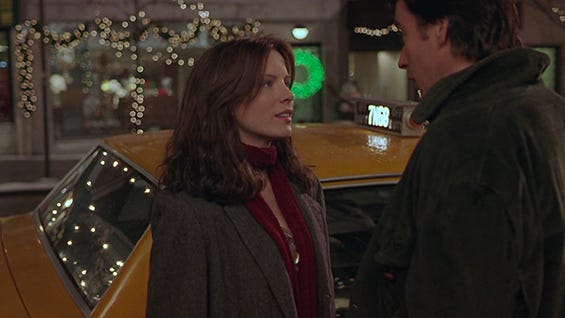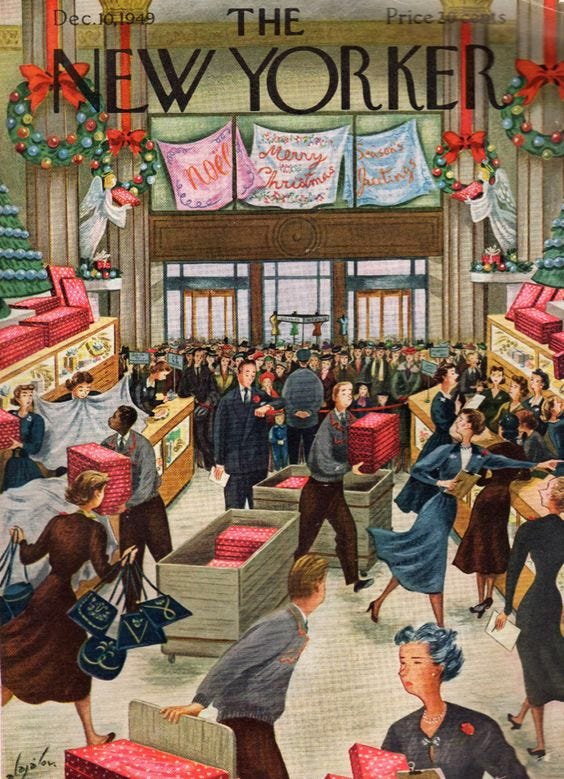Hello. I recently watched the film Serendipity. I would call it a Christmas adjacent film. It’s set in New York. You might like it, too. I’ve also gone down the rabbit hole of 90s christmas in new york aesthetics on Pinterest and Tiktok and it got me thinking about why we long for nostalgia. It almost serves as a psychological anchor that offers a sense of stability and identity through memories, especially in times of uncertainty or transition, reminding us of our roots and the continuity of life's experiences. Do you long for nostalgia, too?
Speaking of nostalgia, this morning, I made a breakfast my grandpa used to make for me when I was a little girl: a bowl of oats, cold whole milk, apple sauce, a sprinkle of cheerios, and a drizzle of honey. Simple but significant.
Okay, moving into today’s news:
-Reading Print Magazine Is An Elite Pursuit
The allure of print magazines positions this medium as a luxurious and intellectually stimulating pursuit in the digital age. It highlights the tactile and immersive experience of reading physical publications, emphasizing their status as a symbol of cultural sophistication and a deliberate choice for deep, thoughtful engagement with content, in contrast to the fleeting nature of digital media consumption.
The article discusses how women have a growing aversion to the birth control pill delves into the complex interplay of medical, psychological, and societal factors influencing this sentiment. It explores the nuanced experiences of women with the pill, highlighting issues around side effects, bodily autonomy, and the broader implications for women's health care, reflecting a shift towards more personalized and informed approaches to contraception.
-The Terrible Twenties? The Assholocene? What to Call Our Chaotic Era
The New Yorker's contemplative piece on naming our current, tumultuous era probes the challenge of encapsulating the complex tapestry of global upheavals, technological disruptions, and cultural shifts in a single term. It reflects on the linguistic and philosophical efforts to define a period marked by rapid change and uncertainty, underscoring the power of language in framing our understanding of historical and contemporary experiences.
-The Rise Of Dissociation Music
The article examines how this emerging genre captures the zeitgeist of current times, offering a soundtrack to feelings of disconnection and surrealism in an increasingly chaotic world. It delves into the unique characteristics of dissociation music, highlighting its ability to mirror and resonate with the listener's inner state, creating a space for reflection amidst the noise of everyday life.
-Are Low-Fat Dairy Products Really Healthier?
The New York Times article on low-fat dairy products critically examines the shift in nutritional perspectives, challenging the long-held belief that low-fat options are inherently healthier. It explores the evolving understanding of dietary fats, their impact on health, and the broader implications of these findings for consumer choices and dietary guidelines, shedding light on the complex and often misunderstood role of fats in our diet.
-How The Aritzia Super Puff Became The Cool Girl Puffer
A discussion of the rise of Aritzia's Super Puff jacket as a 'cool-girl' fashion staple delves into the marketing strategies and cultural factors that catapulted this outerwear to iconic status. It highlights how the combination of celebrity endorsements, social media influence, and the jacket's unique design aesthetics resonated with contemporary fashion sensibilities, making it a symbol of urban chic and a must-have in the wardrobes of fashion-forward consumers.
-Since When Are Red Socks and Tights Everywhere?
Vogue's article on the emerging trend of red socks and tights in fashion captures the boldness and vibrancy of this statement accessory in contemporary style. It explores how the striking color and varied textures of red legwear are being embraced as a means of self-expression and a dynamic accent to outfits, reflecting a shift towards more playful and adventurous elements in personal fashion choices.
-Women Know Exactly What They’re Doing WHen They Use ‘Weak Language’
This New York Times article challenges the notion that women should use forceful language to gain power and influence, arguing that so-called "weak language" can be a strategic asset. It highlights how tentative language, often perceived as a lack of assertiveness, actually displays interpersonal sensitivity and adaptability, making it a potent tool for women in negotiations and leadership. The article critiques the societal expectation that women should conform to a more forceful communication style, which can lead to negative perceptions and career penalties, emphasizing the need to reassess and value different styles of communication in both men and women.
-Tiny Love Stories: The Unspoken Question Between Us
A collection of brief, poignant narratives about love and relationships. These stories, written by various authors, explore themes such as the complexities of maintaining a connection, the silent yet powerful dynamics between individuals, and the unspoken yet deeply felt questions that often linger in relationships. Each story offers a unique perspective on love, capturing its multifaceted nature in just a few words.
Have a wonderful Sunday. I’ll see you tomorrow morning.
Bye <3






